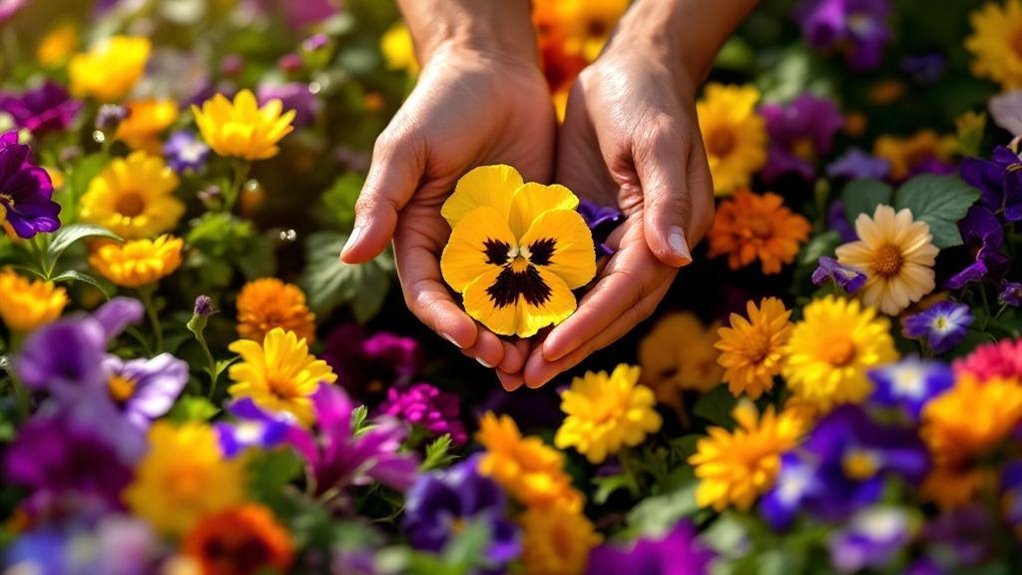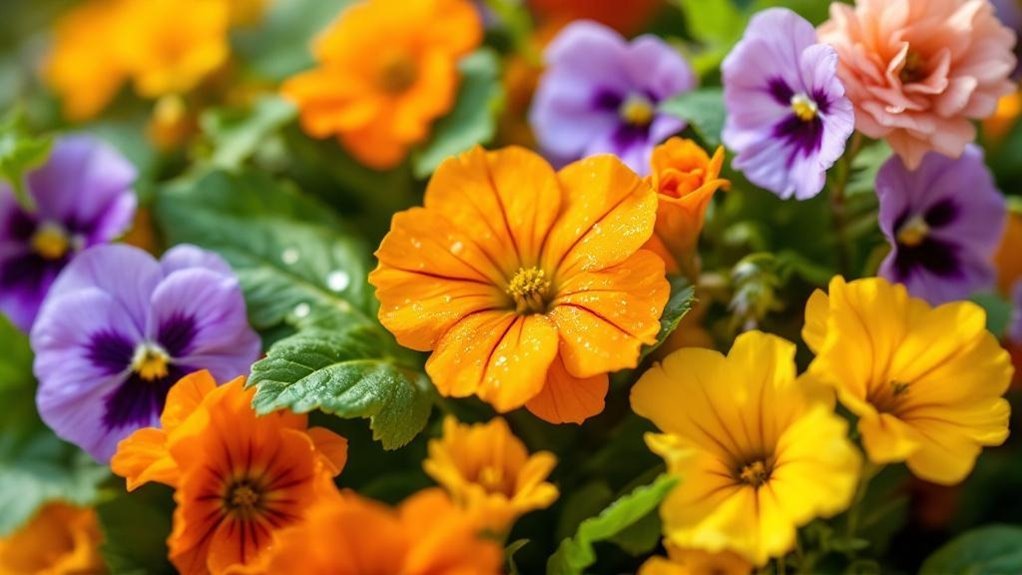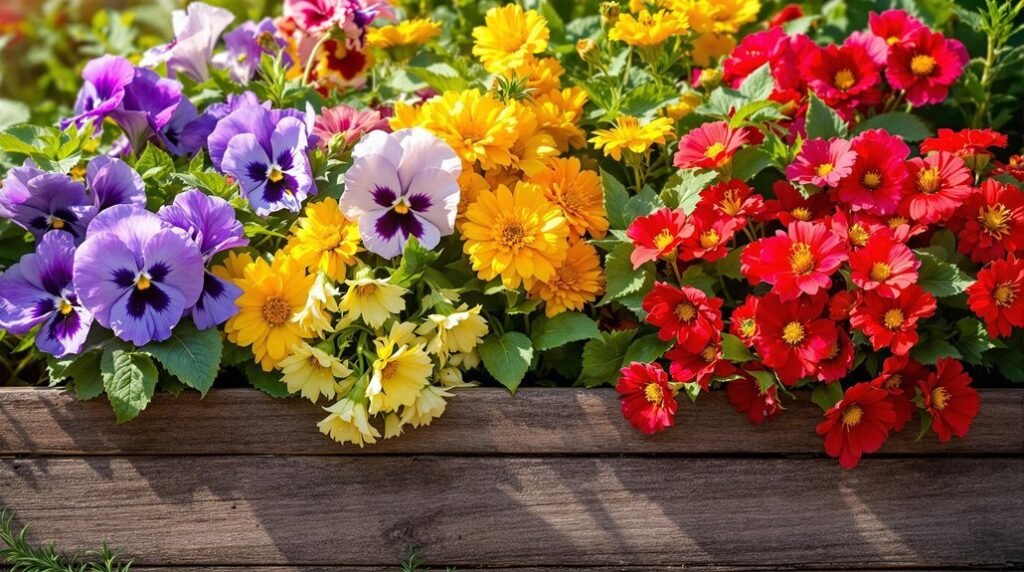If you’re looking to add a fresh twist to your culinary garden, edible flowers offer both beauty and flavor that can transform your dishes. You might already know about nasturtiums or lavender, but there are lesser-known varieties that bring unique tastes and textures to the table. Growing these flowers can also support your garden’s ecosystem in surprising ways. Before you pick your favorites, consider how each variety performs in the kitchen and garden.
Benefits of Growing Edible Flowers
When you grow edible flowers, you not only boost your culinary creativity by adding unique flavors and vibrant colors to your dishes, but you also support your garden’s health by attracting beneficial insects like bees and butterflies.
These flowers bring fresh flavor to salads and other meals, making each bite more exciting and nutritious. Many edible varieties offer antioxidants, helping you incorporate crucial nutrients into your diet effortlessly.
By cultivating these flowers, you encourage biodiversity, creating a thriving ecosystem that benefits various plant and insect species. Growing edible flowers is simple and rewarding, giving you a fun way to experiment with cooking while fostering a healthy, vibrant garden.
This dual benefit makes edible flowers a must-have for any culinary gardener.
Popular Edible Flowers for Culinary Use
Although edible flowers might seem like a niche ingredient, you’ll find they bring both color and flavor to your culinary creations. Popular edible flowers like nasturtiums add a sweet, peppery flavor and are often used as garnishes or in the addition to salads. Squash blossoms are a savory treat, perfect stuffed or fried. Lavender flowers offer a lovely, sweet aroma and flavor to dishes, especially baked goods. Chive blossoms bring a mild onion note and beautiful purple hues, making salads pop. These pretty little flowers not only elevate taste but also create stunning presentations.
| Flower | Culinary Use |
|---|---|
| Nasturtiums | Peppery flavor, garnishes |
| Squash Blossoms | Stuffed or fried delicacy |
| Lavender Flowers | Sweet flavor in baked goods |
| Chive Blossoms | Mild onion, salad addition |
| Pansies | Sweet taste, dessert garnish |
Growing and Harvesting Tips for Edible Flowers

You should harvest edible flowers early in the morning to capture their peak flavor and fragrance, as their oils are most concentrated then.
Make certain the flowers are cultivated without pesticides to guarantee they’re safe to eat. Regularly removing spent flowers encourages more blooms, keeping your garden vibrant.
Ensure flowers are pesticide-free for safety and remove spent blooms to promote continuous flowering.
Flowers can be eaten raw and are great in salads, but always remove the white base of nasturtiums to avoid bitterness.
To preserve freshness, store harvested flowers in a breathable container in the refrigerator and wash them gently before use to remove any insects or debris.
Learn more about growing varieties that thrive in your climate, and always use flowers fresh for the best taste and texture in your culinary creations.
Preparing Edible Flowers for Cooking
Since edible flowers contain delicate petals and essential oils, you’ll want to handle them with care during preparation to maintain their vibrant flavor and appearance. Always harvest flowers in the morning when oils are concentrated. Gently wash edible flowers to remove dirt, then dry them carefully. Remove bitter heels and stamens from larger blooms. Many flowers can be used whole; others require petal-only use. Store unused flowers in a plastic container in the fridge to keep them fresh. These flowers can be used in salads for a light, colorful touch or added to a variety of dishes for visual appeal.
| Step | Action |
|---|---|
| 1. Harvest | Early morning for best oils |
| 2. Wash | Gently in cool water |
| 3. Dry | Pat dry carefully |
| 4. Prep petals | Remove bitter heels, stamens |
| 5. Store | In fridge, plastic container |
Unique Flavors and Uses of Edible Flowers

Handling and preparing edible flowers carefully sets the stage for exploring their unique flavors and culinary uses. When you use whole flowers, you reveal a variety of tastes that elevate your dishes.
- Nasturtiums add a sweet, peppery kick, perfect for a bold addition to fruit salads or vinegars.
- Lavender’s sweet flavor shines in iced tea and as an elegant touch when decorating cakes.
- Chive blossoms bring a mild onion flavor, brightening salads, soups, and spreads with color and zest.
- Borage offers a revitalizing cucumber taste, ideal for summer dishes or frozen in ice cubes for drinks.
Edible Flower Varieties for Salads and Garnishes
Five edible flowers stand out for adding vibrant color and unique flavors to salads and garnishes. Nasturtium petals bring a sweet flavor with a peppery kick, making them a great addition to fruit and green salads.
Nasturtium petals add vibrant color and a sweet, peppery flavor to both fruit and green salads.
Pansies and violas from the flowers in your garden offer a mild, sweet flavor that looks beautiful atop desserts and salads alike.
Chive blossoms are edible and add a mild onion taste along with delicate lavender hues, perfect for fresh salads or creamy spreads.
Calendula petals provide vibrant orange color and a slightly peppery flavor, brightening any salad while adding health benefits.
Cornflowers, with their striking electric blue petals, bring a unique, spicy note to dishes and make salads truly eye-catching.
Edible Flowers From Herbs and Vegetables
When you grow herbs and vegetables in your garden, you can also enjoy their edible flowers, which add unique flavors and vibrant colors to your dishes.
These blossoms let you use flowers from a variety of plants to enhance your meals in creative ways.
- Chive blossoms bring a mild oniony flavor, perfect for mixing into cream cheese or sprinkling over soups or salads.
- Squash blossoms are versatile; stuff or fry them, or toss into pasta dishes for a delicate touch.
- Borage flowers offer a cucumber-like sweetness, brightening fruit salads and infused drinks with their blue blooms.
- Nasturtium flowers add a peppery flavor similar to arugula, giving your salads a spicy kick while attracting pollinators.
Using these edible flowers fresh from your garden elevates both taste and presentation.
Avoiding Toxic Flowers in Your Garden
Since many flowers look appealing but can be harmful, you should always verify that any blooms you plan to grow or eat are clearly labeled as edible.
Always confirm flowers are labeled edible before planting or eating to avoid potential harm.
Toxic flowers like daffodils, oleander, foxglove, bluebells, and lily-of-the-valley are common toxic flowers you might want to avoid due to serious health risks.
It’s always best to educate yourself about flower petals and their safety before planting.
Consult local guides to identify Favorite Edible Flowers with proven culinary uses, such as nasturtiums and pansies.
Be cautious of plant bolts that resemble edible varieties but aren’t safe.
Enhancing Dishes With Edible Flowers
Choosing the right edible flowers sets the stage for more than just a safe garden—it opens up exciting possibilities in the kitchen.
When you pick edible flowers to grow, focus on varieties that thrive in full sun and don’t quickly go to seed, ensuring you always have the best part at hand.
You’ll love tossing bright orange nasturtium leaves and flowers into salads for a crisp texture and peppery flavor.
Here’s how to enhance your dishes:
- Use lavender to infuse baked goods with a sweet, citrusy aroma
- Decorate cakes with pansies and violas for a mild, sweet touch
- Stuff and fry squash blossoms for a delicate treat
- Add chive blossoms to salads and spreads for subtle zing
These colorful accents elevate both taste and presentation beautifully.
Frequently Asked Questions
What Are the Tastiest Edible Flowers?
You’ll find nasturtiums tasty with their peppery kick, while chive blossoms add a mild onion flavor. Lavender offers sweet floral notes, borage tastes cucumber-like, and calendula brings a peppery zest. Try them all for variety!
What Are the Best Flowers for Food Garden?
You’ll want nasturtiums, chive blossoms, calendula, squash blossoms, and pansies for your food garden. They’re easy to grow, attract pollinators, and add vibrant colors and unique flavors to your meals.
What Are the Easiest Edible Flowers to Grow?
You’ll find nasturtiums thrive even in poor soil, making them one of the easiest edible flowers to grow. They bloom vibrantly under full sun, adding a sweet, peppery flavor to your salads effortlessly.
What Flowers Do Chefs Use?
Chefs use nasturtiums for their peppery kick, lavender for sweet fragrance, squash blossoms for delicate flavor, pansies and violas for vibrant color, and chive blossoms to add mild onion notes. You’ll love their versatility!
Final Thoughts
By adding edible flowers like nasturtiums, lavender, and chive blossoms to your culinary garden, you’re painting your dishes with nature’s vibrant palette. Imagine a salad sprinkled with colorful petals or a dessert kissed by sweet pansies—each bite bursting with unique flavors and aromas. Growing these blooms not only delights your taste buds but also invites buzzing bees and fluttering butterflies, turning your garden into a lively, fragrant masterpiece. Let edible flowers transform your cooking and garden alike.
